Horsfield's tortoise (Russian, Afghan or steppe tortoise)
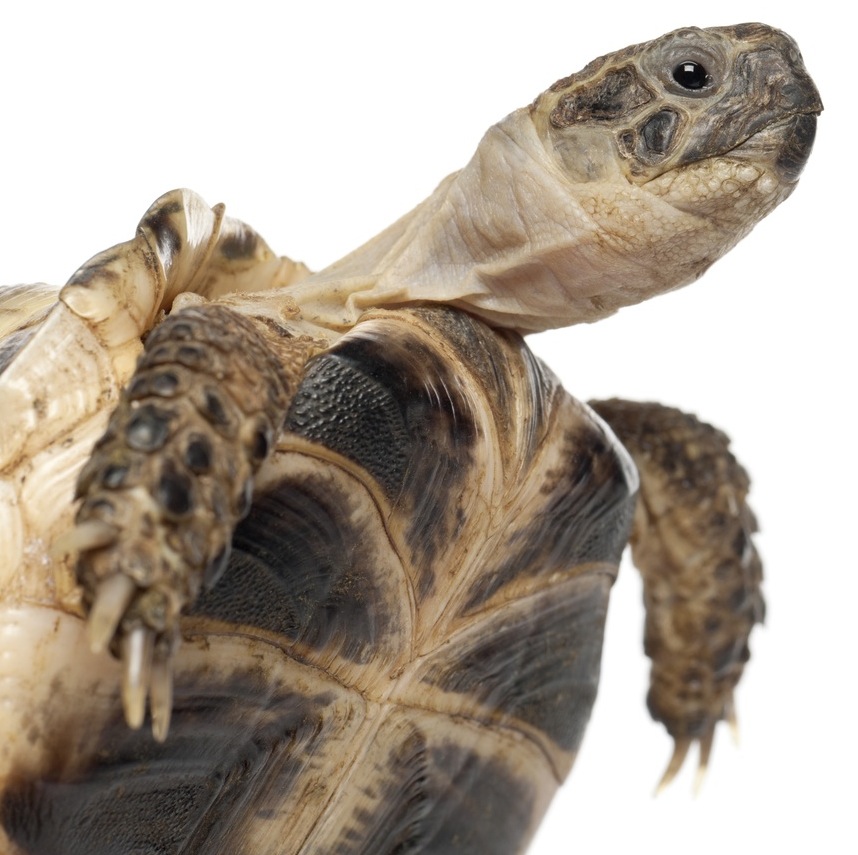
These remarkable tortoises are found further north than any other species, and have evolved to combat climatic extremes. Its overall profile allows Horsfield’s (Agrionemys horsfieldii) to be distinguished easily from other species, as it has a more rounded and flatter shell.
It also ranks as a relative small species of tortoise, with females averaging somewhere between 20-25cm (8-10in) when mature. Males in contrast are about 5cm (2in) shorter.
In addition to being known as Horsfield’s tortoise, this species is also recognised under several other common names. These include Russian tortoise, although this is not an entirely accurate summary of its range. It is also sometimes called the steppe tortoise, describing the type of environment where it is to be found in the wild. It is known too as the four-toed tortoise, having four toes on each foot, and occasionally as the Afghan tortoise.
Range and lifestyle
These tortoises originate from Asia, extending here from northern parts of Iran to the former Soviet republic of Uzbekistan and northwards up into Kazakhstan. Their range extends eastwards as well, through Afghanistan and northern Pakistan as far as north-western parts of China.
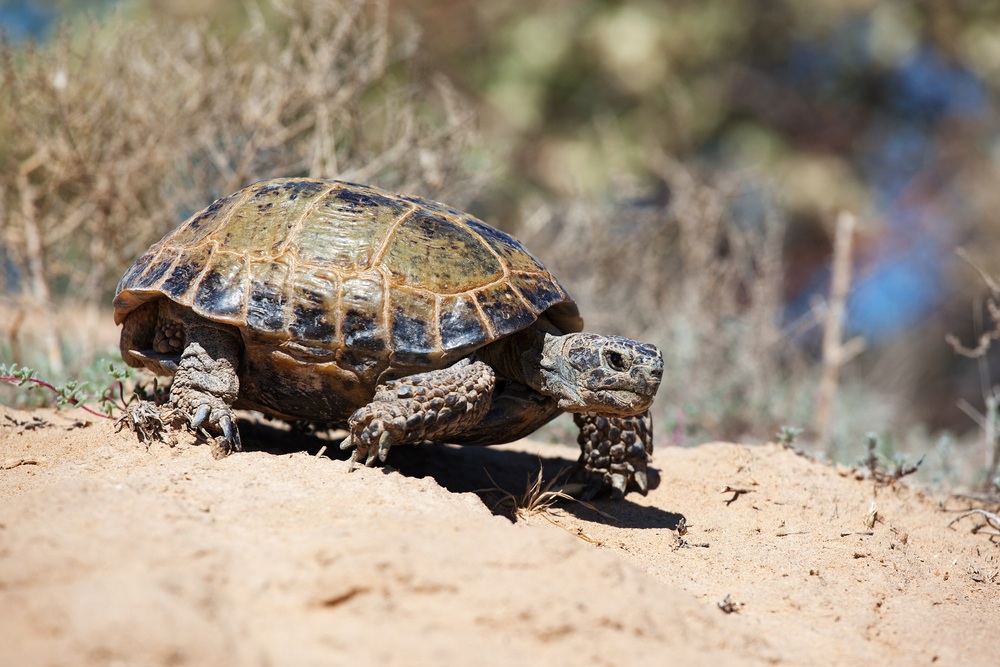
Horsfield’s tortoises are found predominantly in open areas of arid countryside, where there is little vegetation. The soil consists of clay or sand, enabling these tortoises to burrow easily, using their powerful legs and stout claws, with such behaviour being essential to their survival.
A number of tortoises live in semi-desert areas around the world, burrowing and resting underground to avoid using energy when food is in short supply. Horsfield’s is no different in this respect, aestivating in this way over the very hot summer period. It is normally active in the morning, retreating to its burrow when the sun is at its hottest, and then emerges again to feed in the latter part of the afternoon.
Where its lifestyle does vary markedly from other tortoises found in arid areas, however, is in the fact that it is forced to spend the winter months in hibernation as well. Studies in Uzbekistan have revealed that Horsfield’s tortoises will emerge from hibernation around the middle of March, and are then active for just three months of the year, before retreating back underground to avoid the heat of the summer sun around the middle of June. They may have a second brief period of activity in the autumn, before returning back underground to hibernate in October, typically for six months.
Did you know?
Horsfield’s tortoise is named not after its discoverer, but after an American doctor and naturalist called Thomas Horsfield, who lived from 1773 until 1859. He became an important figure in natural history circles in London, being a founder of the Royal Entomological Society and the first assistant secretary of the Zoological Society of London in 1824, but was never involved with the tortoise that bears his name. It was simply named after him as an honour.
Care misconceptions
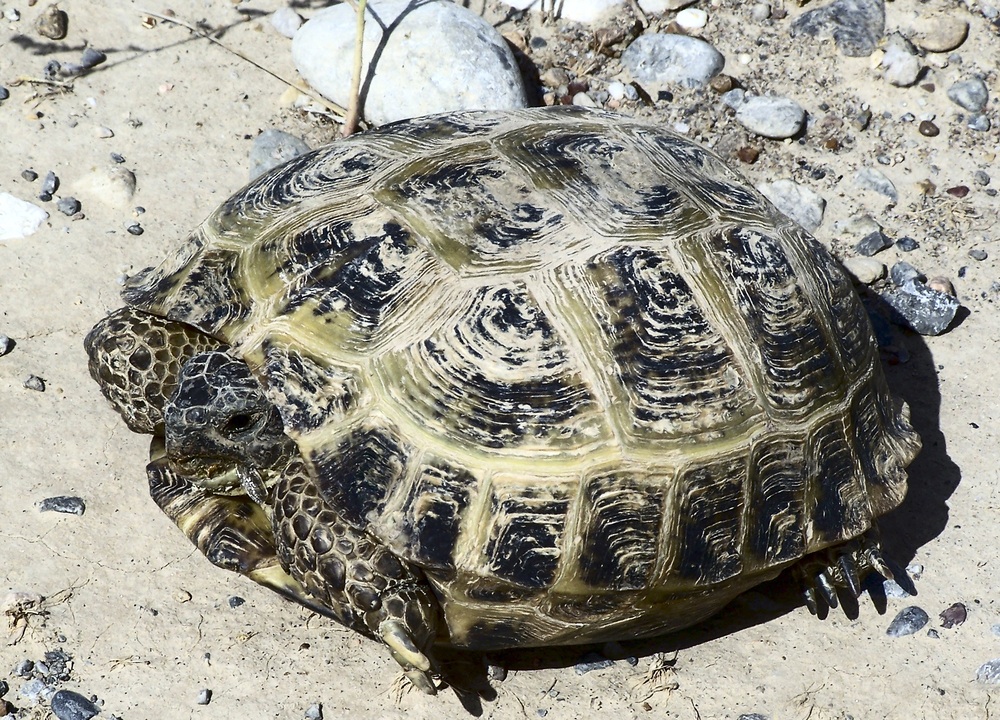
Do not make a critical mistake in assuming that because these tortoises are hardier than their Mediterranean counterparts, so they are therefore better-equipped to survive out-of-doors in temperate areas, such as the UK. They are better adapted to colder conditions, but the key thing to note is that Horsfield’s inhabit arid areas in the wild.
The frequently damp British climate for example means that they will be vulnerable to respiratory illness if allowed out under these conditions, and this can rapidly lead on to pneumonia. They must therefore always have suitable indoor accommodation, for times when the weather is bad.
Health guide
When assessing a tortoise's state of health, check that it is alert, and that its eyes are open when being handled. There should be no discharge from the nostrils, and these should be of even size. Ensure that your vet carries out a test for the presence of parasites on a fresh faecal sample, with any appropriate treatment for worms for example then being given. Certainly over the long term, an accumulation of such parasites can depress the tortoise’s appetite, causing weight loss and leaving your pet susceptible to other health problems.
For further advice about choosing tortoises as pets, click here.
Arrange a health check too before hibernating your pet, with a specialist reptile vet. Note that the table determining weight versus shell length - the so-called Jackson’s Ratio - was not formulated for this species. Instead, you need to consult the McIntyre Ratio, to give you a guide as to whether your pet is of the correct weight to hibernate safely.
For further information about hibernating Horsfield's tortoises safely, see here.
Indoor care
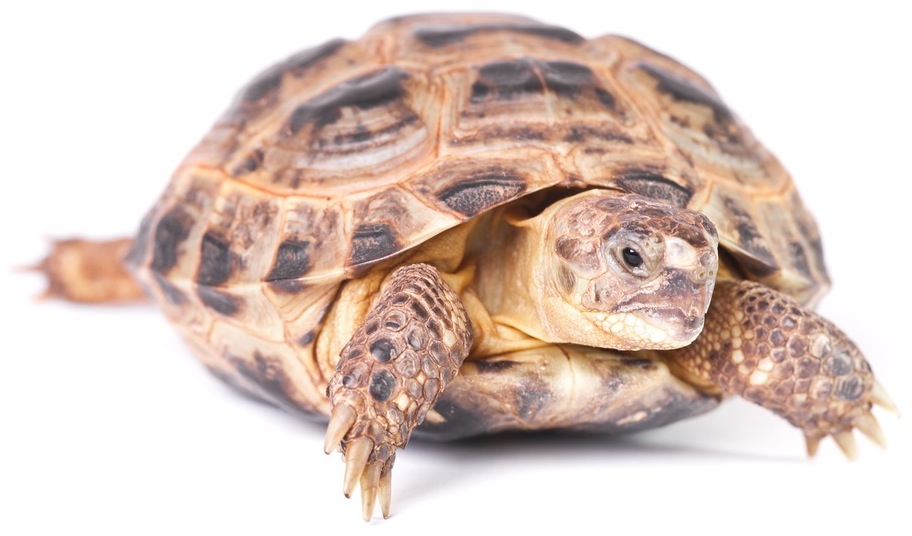
The housing set-up required for these tortoises will be influenced partly by their size. Young hatchlings may be accommodated satisfactorily on a tortoise table, but take particular care with the arrangement of the decor here.
This is because another distinctive characteristic of Horsfield’s tortoises is their readiness to climb. They can be surprising agile, and so a youngster may be able to clamber up perhaps on top of its hide, and then reach the top edge of the table, from where it can tumble down on to the floor, being likely to injure itself as a consequence.
As they grow larger, so it will be a good idea to invest in one of the bigger indoor guinea pig or rabbit runs that are now available. These come in two parts - a plastic base with a detachable wire mesh top. There are several advantages of this type of accommodation, even for a young tortoise. Firstly, since the base unit is not transparent, so that the tortoise will recognise this as a solid barrier, rather than persistently trying to force its way through it. As a result, it will concentrate on using the full area of the run, instead of simply walking up and down the side repeatedly.
Secondly, the height of this barrier means that the tortoise is less likely to be able to reach the mesh above. In outdoor runs, built using a wooden framework where the mesh extends down to ground level, it will almost inevitably start to climb the mesh, using its strong front feet and claws at right angles to its body. This will give it a foothold, and then relying on its more muscular hind legs, the tortoise will power itself up the barrier.
Almost certainly, this behaviour has evolved in the wild to reflect the fact that these tortoises may be found in areas strewn with boulders, which may obstruct their path, and so they need to be able to climb effectively. This can bring danger however, even though they are quite adept at righting themselves if they topple over. Should your tortoise fail to do so, when out on a lawn in a run during the summer, then it will be vulnerable to heat stroke, and it could die as a consequence. It is important to check two or three times during the course of a day that your tortoise is safe in its run therefore, when it is outside.
Russian (Horsfield's) tortoise - yellow Cleanliness, heating and lighting
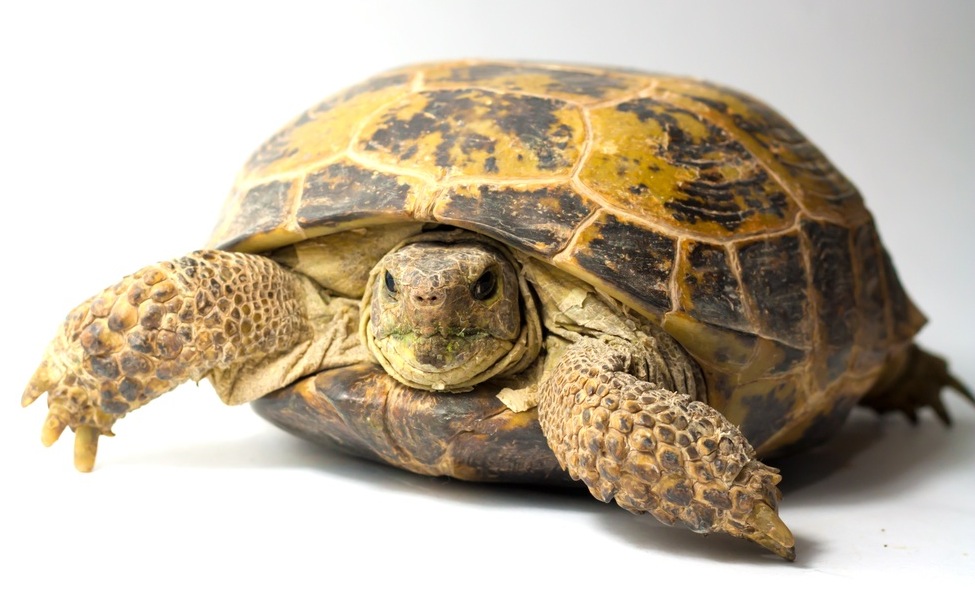
Another benefit of the plastic-bottom type of indoor run is that it is easy to clean as required, particularly if you line it with newspaper. Soiled bedding on top can simply be removed with the paper being folded up, so it can be disposed of easily.
Also, when you are cleaning this area, there is no risk of your tortoises escaping, and it should be quite safe here from being disturbed here by dogs, or outdoors by urban foxes, which can potentially prey particularly on smaller tortoises if they can gain access to them.
There is also no need to invest in separate units to meet the tortoise’s heating and ultra-violet required. A combined heat and ultra-violet (UV) bulb, mounted in a reflector, can be sited on the roof of the run, at one end of the unit, so as to create a thermal gradient along its length. The basking spot temperature should be 32°C (90°F).
Check this in advance with a thermometer positioned where the top of the tortoise’s shell would be located. If necessary, you can suspend the bulb at a higher level, but it must still be positioned horizontally, directly above the tortoise’s quarters.
This type of run is flexible too. It can be used during the summer months outside, particularly if the weather is changeable. You can provide some shade at one end very easily, simply by placing paper over the run here, weighed down with stones to prevent it from blowing away. The tortoise can then benefit from the sun’s UV rays, which will aid their appetite and calcium metabolism.
Dietary matters
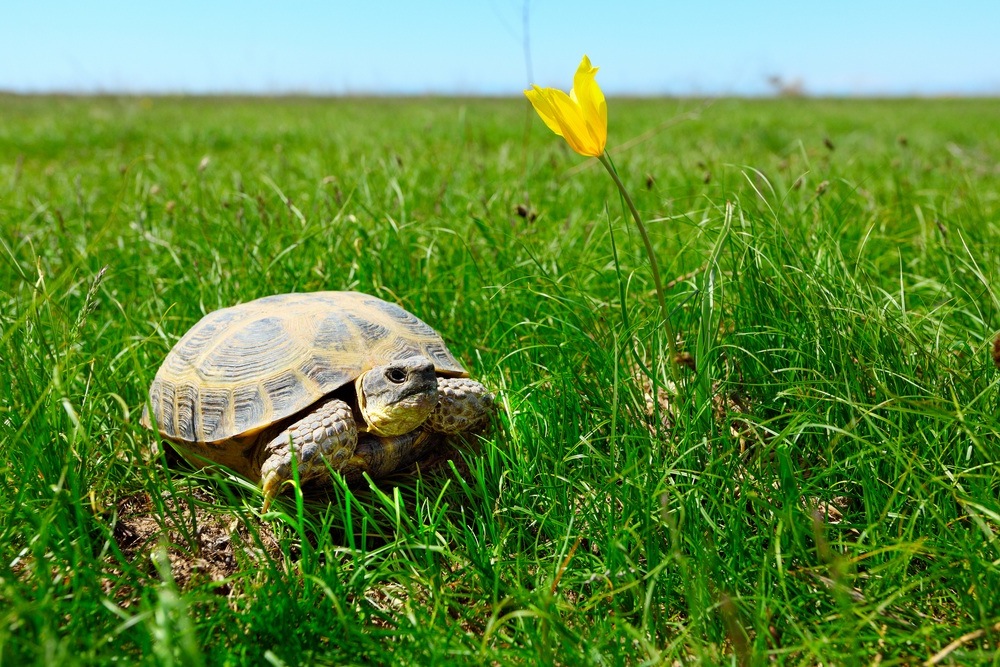
As might be expected, based on the habitat in which they occur, as shown here, Horsfield’s tortoises are grazers, seeking out vegetation that becomes quite dry as summer advances. Fruit should not feature in their diet therefore.
Being herbivores, it is not unknown for these tortoises to eat grass but they require a mixed diet of herbage, particularly one that includes dandelion leaves and flowers. This frequently overlooked plant is a very valuable natural source of calcium, which will be vital for healthy skeletal and shell developing, as well as being an integral ingredient in the eggshell.
It is also worth remembering the natural feeding pattern of this species, which will eat avidly during the spring and early summer, when dandelions are readily available. Even if you cannot get your tortoise outside every day, do try to allow it outside whenever the weather is favourable, or if not, feed it indoors.
A high fibre diet is important for Horsfield’s tortoises, so when providing food, it can also be a good idea to chop up some good quality hay, as sold in packaged form in pet shops, to mix with the greenstuff on offer. A special vitamin and mineral supplement, produced for reptiles, should be sprinkled on their food regularly. A mixture of foods is also a good idea, and this can include one of the specially-formulated, high fibre pelleted diets that are now available for this particular species, although greenstuff should remain their main food.
A healthy diet is crucial component in preventing pyramiding of the shell. You can find more information about this health issue here.
Singles versus pairs
It is often a common misconception that tortoises should be housed in pairs, but there is no evidence to suggest that they forming lasting bonds in the wild. For much of the year, the sexes ignore each other, but you may encounter some difficulties in the spring, particularly should your tortoises be housed within the confines of a run, rather than being able to roam more widely across your garden.
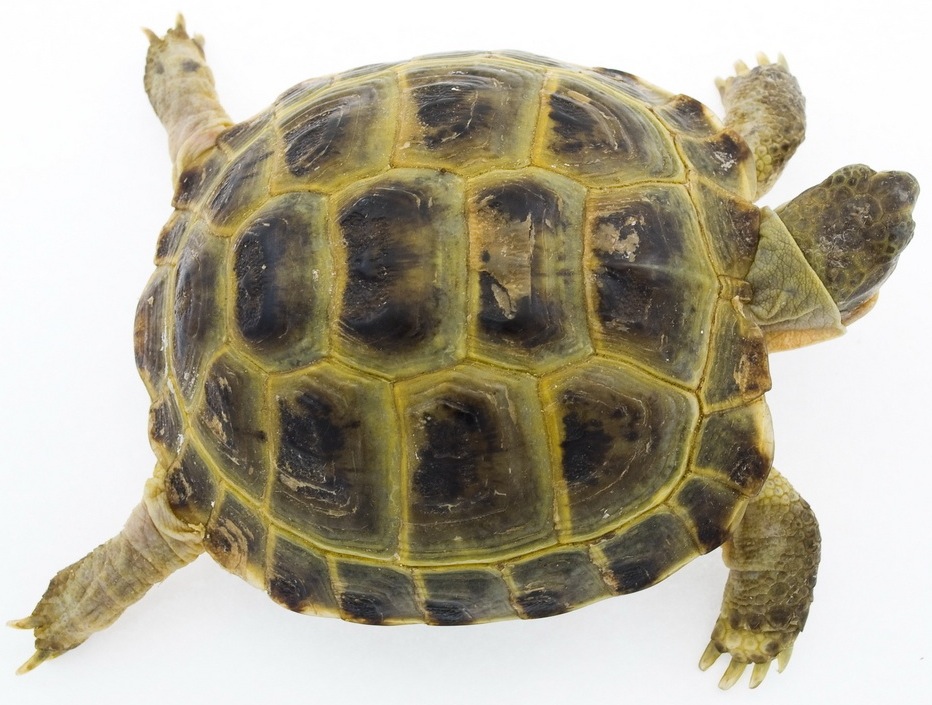
This is because a male Horsfield’s will often pursue a female very determinedly at this time of year, to the point where she may be unable to eat in peace for any length of time. Although he will probably not batter her shell from behind, unlike males of the Mediterranean species, he will bite quite savagely at her legs and feet. This is carried out with the aim of deterring her from walking off, in the hope that he will then be able to mate with her. Such behaviour can sometimes lead to the loss of scales off her front legs, which may even cause some superficial bleeding.
If you want to keep these tortoises together therefore, then house them in trios, which will mean that the male will have two females to chase at this time of year, giving them more respite, although if you are worried, it is still advisable to separate them.
Sexual maturity in these tortoises is based not on age, but on size. Males may start mating when they are just 10cm (4in) long, and occasionally females will lay while they are still under 12.5cm (5in). It may be that the male’s behaviour allows you to sex it reliably, before its gender is clear from the shape and length of its tail, which will be longer than that of a female.
It is usually possible - at least with experience and keen observation - to tell when a female will be ready to lay, as she will become more restless than usual, even outside in the garden. She is likely to lay 1-5 hard-shelled, relatively large eggs in a clutch, having laboriously dug a nest which she will then fill in again, concealing their presence.
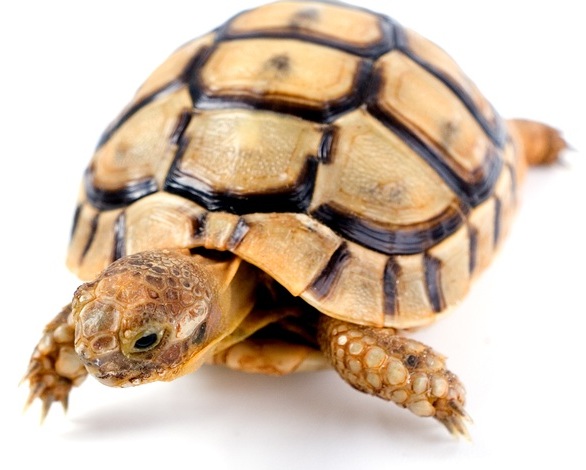
Incubation and hatching
There is no likelihood of them hatching outdoors in temperate areas, so you will need to incubate the eggs indoors. Horsfield’s tortoises are one of those chelonians where the incubation temperature determines the gender of the offspring - a case of so-called Temperature Sex Determination (TSD). The incubation temperature should be maintained between 30-32°C (86-89°F). At the lower end of this temperature range, hatchlings of both sexes can be anticipated, while at the upper end, females will predominate. The eggs can be supported on a bed of damp vermiculite, which is a sterile incubation medium, with the relative humidity in the incubator being maintained at 80%.
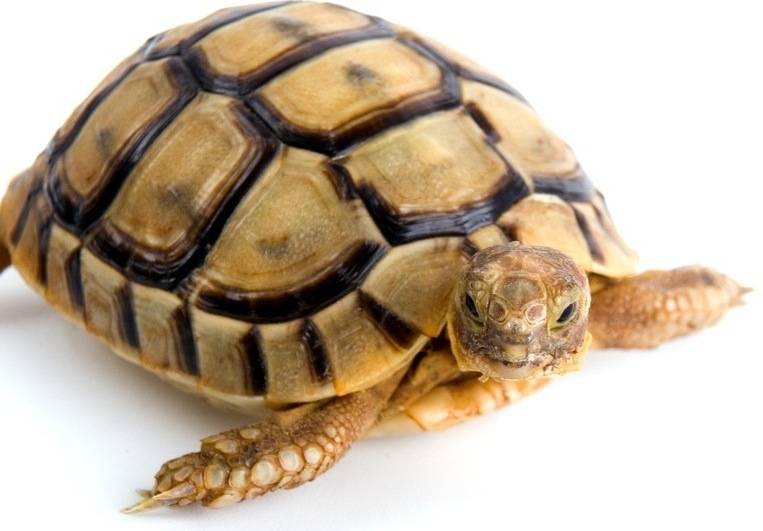
Do not worry if the hatchlings take a couple of days to free themselves from the egg, and that at first, they may appear slightly compressed and misshapen. This is normal, and they will soon look normal. It is also not uncommon for them to display signs of their yolk sac at first, on the underside of the body. This will be absorbed within a few days, and the tortoise will then start eating.
A legal note
In contrast with Mediterranean species such as the Mediterranean spur-thighed tortoise, Horsfield’s tortoises do not require Article 10 paperwork within the European Union, to prove that they are being legitimately held, nor do they need to be microchipped. However, it is still recommended to have your pet microchipped, because if it strays or is stolen and then recovered, microchipping can be used to trace you and confirms that you are the owner. It is also a good idea to get a receipt when you purchase your tortoise, to confirm its origins and age, if known.